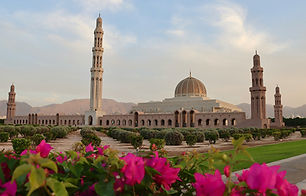Situated on a cove surrounded by volcanic mountains, Muscat is the capital city of Oman. The town’s unusual architecture shows Arab, Portuguese, Persian, Indian, African, and modern Western influences. Two 16th-century Portuguese forts overlook the town. Muscat’s old wall still stands, as well as some of its gates.

Sultan Qaboos Grand Mosque
With its striking domes, intricate carvings, and gleaming white marble façade, the mosque can host up to 20,000 worshipers. Its main prayer hall is adorned with the world's second-largest single-piece carpet and chandelier. The mosque spanning 416,000 square meters, includes meticulously landscaped gardens and tranquil courtyards.

Royal Opera House
Hosting world-class performances ranging from opera and ballet to symphonies and theatrical productions (like Plácido Domingo, Andrea Bocelli, Renée Fleming), it serves as a vibrant hub for artistic expression and cultural exchange.

National Museum
Housed within a magnificent contemporary structure that seamlessly blends modern design with traditional Omani architectural elements, the Museum offers a comprehensive exploration of the nation's past, from its ancient civilizations around two million years ago to its vibrant present.

Al Alam Palace
Nestled amidst lush gardens and overlooking the picturesque Muscat Bay, this magnificent Palace serves as the ceremonial residence of His Majesty Sultan Haitham bin Tariq Al Said. Adorned with vibrant colors and intricate Islamic motifs, the Palace's facade radiates elegance and grandeur, reflecting Oman's rich cultural legacy.

Muttrah Fort
Originally built by the Portuguese in the 16th century and later extensively renovated by the Omanis, this imposing fortress offers panoramic views of the port of Muscat and the Gulf of Oman. Its sturdy walls and strategic location once served to protect the city from maritime invasions and pirate attacks.

Muttrah Corniche
A picturesque promenade that winds along the waterfront of Muscat's historic Muttrah district, lined with palm trees and dotted with traditional Omani architecture, the corniche provides stunning views of the azure waters of the Gulf of Oman and the rugged mountains that frame the city's skyline.

Muttrah Souq
Lose yourself in a maze of winding alleys filled with vibrant stalls offering a treasure trove of traditional Omani handicrafts, spices, textiles, and souvenirs. Dating back centuries, this bustling bazaar is one of the oldest marketplaces in the Arab world, offering a timeless glimpse into Oman's vibrant heritage.

Fish Market
Oman's newest fishing market is a 4,000 square meter, state-of-the-art facility that seamlessly blends old-world charm with modern amenities. Serving as a vibrant public meeting space, the market offers a diverse array of fresh seafood from over 100 sellers and cutters.
.jpg)
Al Jalali Fort
Originally constructed in the 16th century by the Portuguese, this formidable fortress served as a defensive bastion against maritime invaders. Today, visitors can witness the breathtaking views of the surrounding landscape and explore its ancient ramparts, towers, and courtyards, immersing themselves in the storied past of Muscat's coastal defenses.

Al-Mirani Fort
Built before the Portuguese occupation in the 16th century, this imposing fortress once served as a defensive stronghold guarding the entrance to Muscat Bay. The fort became the first to use cannons in Oman.

Bait Al Zubair Museum
The privately owned Museum displays the Zubair family’s collection of Omani artefacts that span a number of centuries. The beautifully restored house, one of the country’s architectural icons, exhibits traditional handicrafts, furniture, stamps and coins across five separate buildings.



